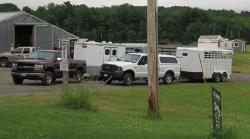As a journalist of many years, I think I struggle more than the average person when accusations of “fake news” and “alternative facts” splash across our daily readings.
For me, the attack is not just on “liberal news outlets” but on media and the propagation of information in general. It’s an attack on journalism’s very basic mission to fairly inform readers, listeners, and viewers.
It’s also hits home because I’ve heard it before:
Years ago, NickerNews was on the forefront of reporting one of the largest animal cruelty cases that Maine had ever seen. The website posted many stories about Brett and Alexis Ingraham, a couple in Clinton running “Fair Play Farm.” (An incongruous name if ever there was one.)
NickerNews assisted the District Attorney’s office when it asked for help with collecting information and witness testimony. After 15 horses as well as other animals were removed from the Ingrahams’ possession, NickerNews updated readers on the status of the case. Eventually, the couple was convicted.
The Ingrahams did not appreciate the coverage and called it untrue and “fake news.”
Then and now, readers must engage and ask ourselves important questions about the source of the information, the evidence to support stated assertions, and the track record of the news outlet. This reader responsibility is not unlike the prudence necessary for evaluating science reports as explained here in this article on the evidence-based model.
Some additional questions to ask ourselves:
— If we only listen to the news that makes us feel good, how do we grow?
— If journalists only write about approved topics with supportive bias, how is the reader (and therefore the greater society) helped?
— If we, as journalists and as readers are not encouraged to ask questions, think critically, and occasionally argue, what’s the point of having a thinking brain and living in a community?
Whether we’re looking for good horse information or good news information, we should be encouraged to dig deep, look for the sources’ angles, and weigh alternative points of view. We should be aware of conflicts of interests and ulterior motives. Abusers, people with something to hide, vested parties all routinely blame the messengers.
The mission here at NickerNews and BestHorsePractices is to help owners and riders improve horses’ lives. We value transparency and objectivity. We appreciate discourse and love hearing from readers.
Thanks for your support!


Thank you ! It is so important to not stifle news, which is after all, shared information. It more often than not exposes crime, dangerous behavior and possible threats to human and animals alike. Being careful to know your sources will help distinguish real information or fake information.:)
HI, Maddy…I am really enjoying becoming familiar with your perspectives and look forward to exploring some things with you relative to what constitutes “evidence”…particularly in my sphere of interest and experience, of course: saddles and interface systems. So much of what I have observed in a quest (of almost 20 years) would likely be considered anecdotal. We observe the horse and assess feedback offered by perceived efficiency of movement in the moment as well as state of body over time…expression, attitude and behavior, too, of course. How I wish I had more video in the vault! But, alas, I lacked the assistance that would have made disciplined documentation possible.. At any rate, I REALLY look forward to sharing some experiences with you and your treasured horses & mules this spring so we can compare notes. Three cheers for you and the community of courageous journalists who shine light over the participants on the stage, keep them transparent and hold them accountable!.